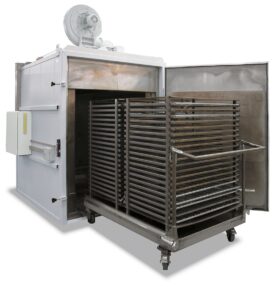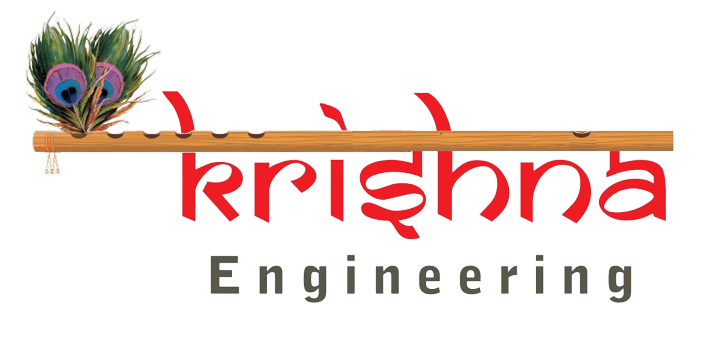What is Industrial ovens ?
Industrial ovens are large-scale heating equipment used in various industries for heating, curing, drying, baking, or other thermal processing applications. These ovens are designed to handle high volumes, accommodate large items or batches, and provide precise temperature control and uniform heat distribution.
An industrial oven is a device used to create high temperatures to heat treat parts, condition metals, and cure metal coatings. The two main types of industrial ovens are continuous and batch. As the name batch implies, batch industrial ovens treat large numbers of parts at the same time. Continuous industrial ovens are normally a part of mass production and may include heating and cooling functions.
The operating for industrial ovens depend on how they are used. Gas, electricity, steam, hot water, microwaves, or fuel oil batch or conveyor loaded industrial ovens.

Industrial ovens called cabinet or Walk-in/Truck-in ovens, batch ovens allow for curing, drying or baking in small batches using wheeled racks, carts or trucks. Ovens such as this are often found in large-volume bakeries in places such as supermarkets.
Electrically heated ovens use electricity and have quick heat-up times, precision temperature controls, and low cost. They are ideal for dealing with combustible products or working with metals like aluminum, which can discolor when heated by gas.
How does an industrial oven work?
When describing how an industrial oven works, the first thing to be considered is the type of fuel used to heat the oven, which can be hot water, direct and indirect gas, ultraviolet light, steam, and electricity.
The second consideration, and essential factor, is the industrial ovens airflow pattern, which can be:
- Horizontal – for products loaded on shelves or hung
- Horizontal/Vertical – Air is returned through ceiling ducts
- Vertical/Horizontal – The air supply comes from the ceiling and exits through return ducts on the walls.
- Vertical/Top Down or Bottom Up – Parts are hung or on perforated shelves. Air flows from the ducts to the return supply.
The airflow has to move with minimal obstructions and at a constant rate to maintain uniform oven temperature.
What are industrial ovens used for?
Industrial ovens are used for large and small applications from applying coatings to small electronic components to baking finish coatings on parts for airplanes and trucks. In cleanrooms, they remove moisture to help remove and contain contaminants.
Uses for Industrial Ovens
The list of uses of industrial ovens is very long and extensive. They have become an essential part of every form of manufacturing for the improvement of product performance and reliability. Described below are a few of the more common uses.
Sterilization
Industrial ovens are used to sterilize medical devices and instruments as can be seen in the dry heat sterilizer pictured below. The medical industry requires equipment with precise temperature control for the removal of bacteria, microbes, and viruses. The precision controls of industrial ovens ideally fit the required conditions.
Applications
Air circulation and temperature control allow industrial ovens to perform cooking, baking, curing, and other low temperature operations. High temperatures of industrial furnaces make them able to complete more robust operations such as tempering, annealing, and carburizing.
Here are some common types and applications of industrial ovens:
Batch Ovens: Batch ovens are versatile and widely used in industries such as food processing, pharmaceuticals, electronics, and automotive. They are designed to accommodate a range of products and materials in batch quantities. Batch ovens can be used for processes like drying, curing, sterilizing, aging, and thermal testing.
Conveyor Ovens: Conveyor ovens feature a continuous conveyor belt that moves products through the oven at a controlled speed. They are used in industries such as manufacturing, automotive, and food processing for applications like curing coatings, drying printed materials, baking, and heat-treating. Conveyor ovens offer high productivity and automation, allowing for continuous processing of large quantities of items.
Tunnel Ovens: Tunnel ovens are designed with a long, straight heating chamber or tunnel through which products pass on a conveyor system. They are commonly used for continuous processes like baking, drying, or heat treatment of items such as bread, biscuits, metal parts, ceramics, and glass. Tunnel ovens offer efficient heat transfer and precise temperature control.
Drying Ovens: Drying ovens are specifically designed for removing moisture or solvents from products or materials. They are used in industries such as pharmaceuticals, chemicals, textiles, and paper manufacturing. Drying ovens facilitate controlled evaporation and drying of substances while maintaining product quality and consistency.
Curing Ovens: Curing ovens are used for the polymerization, hardening, or cross-linking of coatings, adhesives, composites, or other materials. They are commonly found in industries like automotive, aerospace, electronics, and furniture manufacturing. Curing ovens provide controlled heating and curing cycles to achieve proper bonding and desired material properties.
Annealing Ovens: Annealing ovens are designed for the heat treatment of metals to improve their mechanical properties, relieve stress, or enhance their microstructure. These ovens are used in industries such as metal fabrication, automotive, and aerospace. Annealing ovens typically involve controlled heating and cooling cycles to achieve the desired material properties.
Cleanroom Ovens: Cleanroom ovens are specialized ovens used in cleanroom environments where strict control over contamination is required. These ovens maintain cleanliness through HEPA or ULPA filtration systems, ensuring the purity of the process and preventing particles or contaminants from entering the oven chamber.
Industrial ovens offer precise temperature control, uniform heat distribution, and advanced features such as programmable controllers, safety interlocks, and monitoring systems. They are widely used in various industries to perform thermal processes efficiently, improve product quality, and ensure compliance with industry standards and regulations.
Worldwide Exports Location:
Following Countries: Afghanistan, Albania, Algeria, Andorra, Angola, Antigua And Barbuda, Argentina, Armenia, Australia, Austria, Azerbaijan, Bahamas, Bahrain, Bangladesh, Barbados, Belarus, Belgium, Belize, Benin, Bhutan, Bolivia, Bosnia And Herzegovina, Botswana, Brazil, Brunei, Bulgaria, Burkina Faso, Burundi, Cabo Verde, Cambodia, Cameroon, Canada, Central African Republic (CAR), Chad, Chile, Colombia, Comoros, Democratic Republic Of The Congo, Republic Of The Congo, Costa Rica, Cote D’Ivoire, Croatia, Cuba, Cyprus, Czech Republic, Denmark, Djibouti, Dominica, Dominican Republic, Ecuador, Egypt, El Salvador, Equatorial Guinea, Eritrea, Estonia, Ethiopia, Fiji, Finland, France, Gabon, Gambia, Georgia, Germany, Ghana, Greece, Grenada, Guatemala, Guinea, Guinea-Bissau, Guyana, Haiti, Honduras, Hungary, Iceland, India, Indonesia, Iran, Iraq, Ireland, Israel, Italy, Jamaica, Japan, Jordan, Kazakhstan, Kenya, Kiribati, Kosovo, Kuwait, Kyrgyzstan, Laos, Latvia, Lebanon, Lesotho, Liberia, Libya, Liechtenstein, Lithuania, Luxembourg, Macedonia (FYROM), Madagascar, Malawi, Malaysia, Maldives, Mali, Malta, Marshall Islands, Mauritania, Mauritius, Mexico, Micronesia, Moldova, Monaco, Mongolia, Montenegro, Morocco, Mozambique, Myanmar (Burma), Namibia, Nauru, Nepal, Netherlands, New Zealand, Nicaragua, Niger, Nigeria, North Korea, Norway, Oman, Pakistan, Palau, Palestine, Panama, Papua New Guinea, Paraguay, Peru, Philippines, Poland, Portugal, Qatar, Romania, Russia, Rwanda, Saint Kitts And Nevis, Saint Lucia, Saint Vincent And The Grenadines, Samoa, San Marino, Sao Tome And Principe, Saudi Arabia, Senegal, Serbia, Seychelles, Sierra Leone, Singapore, Slovakia, Slovenia, Solomon Islands, Somalia, South Africa, South Korea, South Sudan, Spain, Sri Lanka, Sudan, Suriname, Swaziland, Sweden, Switzerland, Syria, Taiwan, Tajikistan, Tanzania, Thailand, Timor-Leste, Togo, Tonga, Trinidad And Tobago, Tunisia, Turkey, Turkmenistan, Tuvalu, Uganda, Ukraine, United Arab Emirates (UAE), United Kingdom (UK), United States Of America (USA), Uruguay, Uzbekistan, Vanuatu, Vatican City (Holy See), Venezuela, Vietnam, Yemen, Zambia, Zimbabwe.
India Location –
Maharashtra, Mumbai, Pune, Nagpur, Nashik, Virar, Palghar, Aurangabad, Bhiwandi, Thane, Amravati, Malegaon, Kolhapur, Nanded, Sangli ,Jalgaon, Akola, Latur, Ahmadnagar, Dhule, Ichalkaranji, Chandrapur, Parbhani, Jalna, Bhusawal, Navi Mumbai, Raigad, Panvel, Bangalore, Karnataka, Ahmedabad, Gujarat, Chennai, Tamil Nadu, Surat, Coimbatore, Vadodara, Indore, Madhya Pradesh, Bhubaneswar, Orissa, Hyderabad, Andhra Pradesh, Jamshedpur, Jharkhand, Kolkata, West Bengal ,Delhi, Jaipur, Rajasthan, Kochi, Kerala, Chandigarh, Punjab, Dehradun, Uttarakhand , Lucknow, Uttar Pradesh, Visakhapatnam, Andhra Pradesh, Guwahati, Assam, Amritsar, Mangalore, Noida, Gurgaon, Haryana, Bhopal, Madhya Pradesh, Aurangabad, Faridabad, Allahabad, Prayagraj, Jodhpur.




